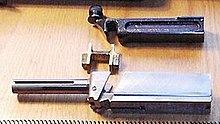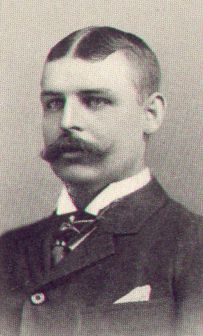Blish closure
The Blish lock (English: Blish lock ) is one of John Bell Blish thought up, to briefly blocking locking system for automatic weapons , which he called Breech closure for firearms patented 1915th He assumed that surfaces interacting with one another would block or stick for a moment if the contact pressure was extremely high. This phenomenon, which he calls Metallic Adhesion and Blish principle in the English specialist literature, contradicts the knowledge of the theory of friction .
Emergence
Captain John Bell Blish (born September 8, 1860, † December 22, 1921), an American naval officer, stated that the bolt head should be blocked against rotation in naval guns with screw locks so that the lock does not open prematurely. In tests with unsecured buckles, Blish found that the bolt head twisted less when firing heavy charges than when firing weak charges. He concluded from this that an extremely high contact pressure between two materials blocks any lateral displacement; figuratively speaking, they “stick” for a moment.
Blish therefore assumed that the coefficient of friction and thus the frictional force increases disproportionately to the point of blocking when the contact pressure between two bodies is extremely high . The principle played a role in the manufacture of automatic handguns after the First World War .
Blish's delayed bulk seal

In order to take advantage of the effect he assumed in firearms, Blish designed a series of fasteners that run up against an inclined surface and are thereby slowed down; he had this patented on March 9, 1915. He became a partner in the Auto-Ordnance Company, NY, run by John T. Thompson . The Thompson self-loading rifle with a screw lock was one of the first weapons whose function was to be based on this principle of the delayed mass lock . However, since the system was not convincing, the company stopped development. In the later Thompson submachine gun , the two locking components were connected by a part called a blish lock , which was intended to delay the return movement of the breech.
Questioning the effect assumed by Blish
The relativization of Amonton's law at high pressures could not be proven experimentally. It is therefore not mentioned in relevant physical books. In Thompson submachine pistols with delayed blowback was recognized that the Blish of metallic adhesion -mentioned effect of the Blish locks does not affect their function. This was already noticed in summer 1921 during demonstrations at the Royal Small Arms Factory in Enfield, England. In Rapport Minute 407 Report by CISA on Thompson SMG, 7-9-21. 77/15/5492 of the Chief Inspector for Infantry Weapons of the British Army , it is doubted that the blish lock has any influence on the function of the weapon. The weapon was shot without the H-piece ( locking wedge ) inserted . It worked perfectly, cartridge extraction and ejection were normal. In addition, the condition of the fired cases was identical to that of cases fired with unmodified weapons.
literature
- WHBSmith, Joseph E. Smith: The Book of Rifles , Copyright 1948 by the National Rifle Association, The Stackpole Co. Harrisburg, PA, USA
- Melvin M. Johnson, Charles T. Haven: Automatic Weapons of the World , Copyright 1945 by the authors. William Morrow & Co. NY, USA.
- Tracie L. Hill: Thompson, the American Legend , Copyright 1996 by Tracie L. Hill, Published by Collector Grade Publications Inc. Cobourg, Ontario, Canada, ISBN 0-88935-208-9
- WHB Smith, Joseph E. Smith: The Book of Rifles , Copyright 1963 by The Stackpole Co. Harrisburg, PA, USA
- Roger A. Cox, The Thompson Submachine Gun , Copyright 1982 by Roger A. Cox, Published by VIII Publishing Company, Conyers, GA, USA.

